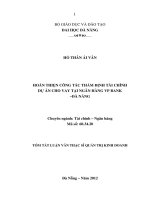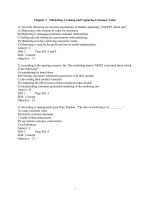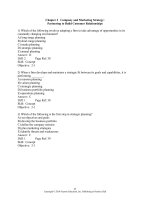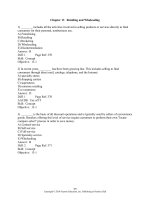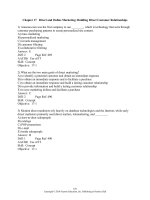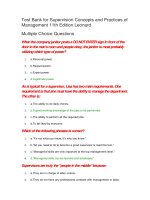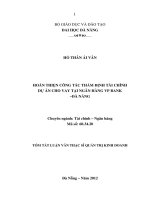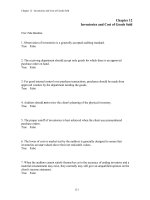Test bank CHAPTER 08 RISK AND RATES OF RETURN Quản trị tài chính
Bạn đang xem bản rút gọn của tài liệu. Xem và tải ngay bản đầy đủ của tài liệu tại đây (548.54 KB, 213 trang )
CHAPTER 08—RISK AND RATES OF RETURN
1. The tighter the probability distribution of its expected future returns, the greater the risk of a given investment as
measured by its standard deviation.
a. True
b. Fals
e
ANSWER:
False
POINTS:
1
DIFFICULTY:
EASY
REFERENCES:
8-2 Stand-Alone Risk
LEARNING OBJECTIVES: FOFM.BRIG.16.08.02 - Stand-Alone Risk
NATIONAL STANDARDS: United States - BUSPROG.FOFM.BRIG.16.06 - Reflective thinking
STATE STANDARDS:
United States - OH - DISC.FOFM.BRIG.16.07 - Risk and return
TOPICS:
Standard deviation
KEYWORDS:
Bloom’s: Knowledge
Cengage Learning Testing, Powered by Cognero
Page 1
CHAPTER 08—RISK AND RATES OF RETURN
2. The coefficient of variation, calculated as the standard deviation of expected returns divided by the expected return, is a
standardized measure of the risk per unit of expected return.
a. True
b. Fals
e
ANSWER:
True
POINTS:
1
DIFFICULTY:
EASY
REFERENCES:
8-2 Stand-Alone Risk
LEARNING OBJECTIVES: FOFM.BRIG.16.08.02 - Stand-Alone Risk
NATIONAL STANDARDS: United States - BUSPROG.FOFM.BRIG.16.06 - Reflective thinking
STATE STANDARDS:
United States - OH - DISC.FOFM.BRIG.16.07 - Risk and return
TOPICS:
Coefficient of variation
KEYWORDS:
Bloom’s: Knowledge
Cengage Learning Testing, Powered by Cognero
Page 2
CHAPTER 08—RISK AND RATES OF RETURN
3. The standard deviation is a better measure of risk than the coefficient of variation if the expected returns of the
securities being compared differ significantly.
a. True
b. Fals
e
ANSWER:
False
POINTS:
1
DIFFICULTY:
EASY
REFERENCES:
8-2 Stand-Alone Risk
LEARNING OBJECTIVES: FOFM.BRIG.16.08.02 - Stand-Alone Risk
NATIONAL STANDARDS: United States - BUSPROG.FOFM.BRIG.16.06 - Reflective thinking
STATE STANDARDS:
United States - OH - DISC.FOFM.BRIG.16.07 - Risk and return
TOPICS:
CV vs. SD
KEYWORDS:
Bloom's: Comprehension
Cengage Learning Testing, Powered by Cognero
Page 3
CHAPTER 08—RISK AND RATES OF RETURN
4. Risk-averse investors require higher rates of return on investments whose returns are highly uncertain, and most
investors are risk averse.
a. True
b. Fals
e
ANSWER:
True
POINTS:
1
DIFFICULTY:
EASY
REFERENCES:
8-2 Stand-Alone Risk
LEARNING OBJECTIVES: FOFM.BRIG.16.08.02 - Stand-Alone Risk
NATIONAL STANDARDS: United States - BUSPROG.FOFM.BRIG.16.06 - Reflective thinking
STATE STANDARDS:
United States - OH - DISC.FOFM.BRIG.16.07 - Risk and return
TOPICS:
Risk aversion
KEYWORDS:
Bloom’s: Knowledge
Cengage Learning Testing, Powered by Cognero
Page 4
CHAPTER 08—RISK AND RATES OF RETURN
5. When adding a randomly chosen new stock to an existing portfolio, the higher (or more positive) the degree of
correlation between the new stock and stocks already in the portfolio, the less the additional stock will reduce the
portfolio's risk.
a. True
b. Fals
e
ANSWER:
True
POINTS:
1
DIFFICULTY:
EASY
REFERENCES:
8-3 Risk in a Portfolio Context: The CAPM
LEARNING OBJECTIVES: FOFM.BRIG.16.08.03 - Risk in a Portfolio Context: The CAPM
NATIONAL STANDARDS: United States - BUSPROG.FOFM.BRIG.16.06 - Reflective thinking
STATE STANDARDS:
United States - OH - DISC.FOFM.BRIG.16.07 - Risk and return
TOPICS:
Portfolio risk
KEYWORDS:
Bloom's: Comprehension
Cengage Learning Testing, Powered by Cognero
Page 5
CHAPTER 08—RISK AND RATES OF RETURN
6. Diversification will normally reduce the riskiness of a portfolio of stocks.
a. True
b. Fals
e
ANSWER:
True
POINTS:
1
DIFFICULTY:
EASY
REFERENCES:
8-3 Risk in a Portfolio Context: The CAPM
LEARNING OBJECTIVES: FOFM.BRIG.16.08.03 - Risk in a Portfolio Context: The CAPM
NATIONAL STANDARDS: United States - BUSPROG.FOFM.BRIG.16.06 - Reflective thinking
STATE STANDARDS:
United States - OH - DISC.FOFM.BRIG.16.07 - Risk and return
TOPICS:
Portfolio risk
KEYWORDS:
Bloom’s: Knowledge
7. In portfolio analysis, we often use ex post (historical) returns and standard deviations, despite the fact that we are really
Cengage Learning Testing, Powered by Cognero
Page 6
CHAPTER 08—RISK AND RATES OF RETURN
interested in ex ante (future) data.
a. True
b. Fals
e
ANSWER:
True
POINTS:
1
DIFFICULTY:
EASY
REFERENCES:
8-3 Risk in a Portfolio Context: The CAPM
LEARNING OBJECTIVES: FOFM.BRIG.16.08.03 - Risk in a Portfolio Context: The CAPM
NATIONAL STANDARDS: United States - BUSPROG.FOFM.BRIG.16.06 - Reflective thinking
STATE STANDARDS:
United States - OH - DISC.FOFM.BRIG.16.07 - Risk and return
TOPICS:
Portfolio risk
KEYWORDS:
Bloom’s: Knowledge
8. The realized return on a stock portfolio is the weighted average of the expected returns on the stocks in the portfolio.
Cengage Learning Testing, Powered by Cognero
Page 7
CHAPTER 08—RISK AND RATES OF RETURN
a. True
b. Fals
e
ANSWER:
False
POINTS:
1
DIFFICULTY:
EASY
REFERENCES:
8-3 Risk in a Portfolio Context: The CAPM
LEARNING OBJECTIVES: FOFM.BRIG.16.08.03 - Risk in a Portfolio Context: The CAPM
NATIONAL STANDARDS: United States - BUSPROG.FOFM.BRIG.16.06 - Reflective thinking
STATE STANDARDS:
United States - OH - DISC.FOFM.BRIG.16.07 - Risk and return
TOPICS:
Portfolio return
KEYWORDS:
Bloom’s: Knowledge
9. Market risk refers to the tendency of a stock to move with the general stock market. A stock with above-average market
risk will tend to be more volatile than an average stock, and its beta will be greater than 1.0.
a. True
Cengage Learning Testing, Powered by Cognero
Page 8
CHAPTER 08—RISK AND RATES OF RETURN
b. Fals
e
ANSWER:
True
POINTS:
1
DIFFICULTY:
EASY
REFERENCES:
8-3 Risk in a Portfolio Context: The CAPM
LEARNING OBJECTIVES: FOFM.BRIG.16.08.03 - Risk in a Portfolio Context: The CAPM
NATIONAL STANDARDS: United States - BUSPROG.FOFM.BRIG.16.06 - Reflective thinking
STATE STANDARDS:
United States - OH - DISC.FOFM.BRIG.16.07 - Risk and return
TOPICS:
Market risk
KEYWORDS:
Bloom's: Comprehension
10. An individual stock's diversifiable risk, which is measured by its beta, can be lowered by adding more stocks to the
portfolio in which the stock is held.
a. True
Cengage Learning Testing, Powered by Cognero
Page 9
CHAPTER 08—RISK AND RATES OF RETURN
b. Fals
e
ANSWER:
False
POINTS:
1
DIFFICULTY:
EASY
REFERENCES:
8-3 Risk in a Portfolio Context: The CAPM
LEARNING OBJECTIVES: FOFM.BRIG.16.08.03 - Risk in a Portfolio Context: The CAPM
NATIONAL STANDARDS: United States - BUSPROG.FOFM.BRIG.16.06 - Reflective thinking
STATE STANDARDS:
United States - OH - DISC.FOFM.BRIG.16.07 - Risk and return
TOPICS:
Market risk
KEYWORDS:
Bloom's: Comprehension
11. Managers should under no conditions take actions that increase their firm's risk relative to the market, regardless of
how much those actions would increase the firm's expected rate of return.
a. True
Cengage Learning Testing, Powered by Cognero
Page 10
CHAPTER 08—RISK AND RATES OF RETURN
b. Fals
e
ANSWER:
False
POINTS:
1
DIFFICULTY:
EASY
REFERENCES:
8-3 Risk in a Portfolio Context: The CAPM
LEARNING OBJECTIVES: FOFM.BRIG.16.08.03 - Risk in a Portfolio Context: The CAPM
NATIONAL STANDARDS: United States - BUSPROG.FOFM.BRIG.16.06 - Reflective thinking
STATE STANDARDS:
United States - OH - DISC.FOFM.BRIG.16.07 - Risk and return
TOPICS:
Risk and expected returns
KEYWORDS:
Bloom's: Comprehension
12. One key conclusion of the Capital Asset Pricing Model is that the value of an asset should be measured by considering
both the risk and the expected return of the asset, assuming that the asset is held in a well-diversified portfolio. The risk of
the asset held in isolation is not relevant under the CAPM.
Cengage Learning Testing, Powered by Cognero
Page 11
CHAPTER 08—RISK AND RATES OF RETURN
a. True
b. Fals
e
ANSWER:
True
POINTS:
1
DIFFICULTY:
EASY
REFERENCES:
8-3 Risk in a Portfolio Context: The CAPM
LEARNING OBJECTIVES: FOFM.BRIG.16.08.03 - Risk in a Portfolio Context: The CAPM
NATIONAL STANDARDS: United States - BUSPROG.FOFM.BRIG.16.06 - Reflective thinking
STATE STANDARDS:
United States - OH - DISC.FFMC.BRIG.15.07 - Risk and return
TOPICS:
CAPM and risk
KEYWORDS:
Bloom's: Comprehension
13. According to the Capital Asset Pricing Model, investors are primarily concerned with portfolio risk, not the risks of
individual stocks held in isolation. Thus, the relevant risk of a stock is the stock's contribution to the riskiness of a welldiversified portfolio.
Cengage Learning Testing, Powered by Cognero
Page 12
CHAPTER 08—RISK AND RATES OF RETURN
a. True
b. Fals
e
ANSWER:
True
POINTS:
1
DIFFICULTY:
EASY
REFERENCES:
8-3 Risk in a Portfolio Context: The CAPM
LEARNING OBJECTIVES: FOFM.BRIG.16.08.03 - Risk in a Portfolio Context: The CAPM
NATIONAL STANDARDS: United States - BUSPROG.FOFM.BRIG.16.06 - Reflective thinking
STATE STANDARDS:
United States - OH - DISC.FOFM.BRIG.16.07 - Risk and return
TOPICS:
CAPM and risk
KEYWORDS:
Bloom's: Comprehension
14. If investors become less averse to risk, the slope of the Security Market Line (SML) will increase.
a. True
Cengage Learning Testing, Powered by Cognero
Page 13
CHAPTER 08—RISK AND RATES OF RETURN
b. Fals
e
ANSWER:
False
POINTS:
1
DIFFICULTY:
EASY
REFERENCES:
8-4 The Relationship Between Risk and Rates of Return
LEARNING OBJECTIVE FOFM.BRIG.16.08.04 - The Relationship Between Risk and Rates of
S:
Return
NATIONAL STANDARDS United States - BUSPROG.FOFM.BRIG.16.06 - Reflective thinking
:
STATE STANDARDS:
United States - OH - DISC.FOFM.BRIG.16.07 - Risk and return
TOPICS:
SML and risk aversion
KEYWORDS:
Bloom’s: Knowledge
15. Most corporations earn returns for their stockholders by acquiring and operating tangible and intangible assets. The
relevant risk of each asset should be measured in terms of its effect on the risk of the firm's stockholders.
a. True
Cengage Learning Testing, Powered by Cognero
Page 14
CHAPTER 08—RISK AND RATES OF RETURN
b. Fals
e
ANSWER:
True
POINTS:
1
DIFFICULTY:
EASY
REFERENCES:
8-6 Some Concluding Thoughts: Implications for Corporate Managers and
Investors
LEARNING OBJEC FOFM.BRIG.16.08.06 - Some Concluding Thoughts: Implications for
TIVES:
Corporate Managers and Investors
NATIONAL STAND United States - BUSPROG.FOFM.BRIG.16.06 - Reflective thinking
ARDS:
STATE STANDARD United States - OH - DISC.FOFM.BRIG.16.07 - Risk and return
S:
TOPICS:
Physical assets
KEYWORDS:
Bloom's: Comprehension
16. Variance is a measure of the variability of returns, and since it involves squaring the deviation of each actual return
from the expected return, it is always larger than its square root, the standard deviation.
Cengage Learning Testing, Powered by Cognero
Page 15
CHAPTER 08—RISK AND RATES OF RETURN
a. True
b. Fals
e
ANSWER:
True
POINTS:
1
DIFFICULTY:
MODERATE
REFERENCES:
8-2 Stand-Alone Risk
LEARNING OBJECTIVES: FOFM.BRIG.16.08.02 - Stand-Alone Risk
NATIONAL STANDARDS: United States - BUSPROG.FOFM.BRIG.16.06 - Reflective thinking
STATE STANDARDS:
United States - OH - DISC.FOFM.BRIG.16.07 - Risk and return
TOPICS:
Variance
KEYWORDS:
Bloom's: Knowledge
17. Because of differences in the expected returns on different investments, the standard deviation is not always an
adequate measure of risk. However, the coefficient of variation adjusts for differences in expected returns and thus allows
investors to make better comparisons of investments' stand-alone risk.
Cengage Learning Testing, Powered by Cognero
Page 16
CHAPTER 08—RISK AND RATES OF RETURN
a. True
b. Fals
e
ANSWER:
True
POINTS:
1
DIFFICULTY:
MODERATE
REFERENCES:
8-2 Stand-Alone Risk
LEARNING OBJECTIVES: FOFM.BRIG.16.08.02 - Stand-Alone Risk
NATIONAL STANDARDS: United States - BUSPROG.FOFM.BRIG.16.06 - Reflective thinking
STATE STANDARDS:
United States - OH - DISC.FOFM.BRIG.16.07 - Risk and return
TOPICS:
Coefficient of variation
KEYWORDS:
Bloom’s: Knowledge
18.
a. True
Cengage Learning Testing, Powered by Cognero
Page 17
CHAPTER 08—RISK AND RATES OF RETURN
b. Fals
e
ANSWER:
True
POINTS:
1
DIFFICULTY:
MODERATE
REFERENCES:
8-2 Stand-Alone Risk
LEARNING OBJECTIVES: FOFM.BRIG.16.08.02 - Stand-Alone Risk
NATIONAL STANDARDS: United States - BUSPROG.FOFM.BRIG.16.06 - Reflective thinking
STATE STANDARDS:
United States - OH - DISC.FOFM.BRIG.16.07 - Risk and return
TOPICS:
Risk aversion
KEYWORDS:
Bloom’s: Knowledge
19. If investors are risk averse and hold only one stock, we can conclude that the required rate of return on a stock whose
standard deviation is 0.21 will be greater than the required return on a stock whose standard deviation is 0.10. However, if
stocks are held in portfolios, it is possible that the required return could be higher on the stock with the lower standard
deviation.
a. True
Cengage Learning Testing, Powered by Cognero
Page 18
CHAPTER 08—RISK AND RATES OF RETURN
b. Fals
e
ANSWER:
True
POINTS:
1
DIFFICULTY:
MODERATE
REFERENCES:
8-2 Stand-Alone Risk
LEARNING OBJECTIVES: FOFM.BRIG.16.08.02 - Stand-Alone Risk
NATIONAL STANDARDS: United States - BUSPROG.FOFM.BRIG.16.06 - Reflective thinking
STATE STANDARDS:
United States - OH - DISC.FOFM.BRIG.16.07 - Risk and return
TOPICS:
Risk aversion
KEYWORDS:
Bloom's: Comprehension
20. Someone who is risk averse has a general dislike for risk and a preference for certainty. If risk aversion exists in the
market, then investors in general are willing to accept somewhat lower returns on less risky securities. Different investors
have different degrees of risk aversion, and the end result is that investors with greater risk aversion tend to hold securities
with lower risk (and therefore a lower expected return) than investors who have more tolerance for risk.
a. True
Cengage Learning Testing, Powered by Cognero
Page 19
CHAPTER 08—RISK AND RATES OF RETURN
b. Fals
e
ANSWER:
True
POINTS:
1
DIFFICULTY:
MODERATE
REFERENCES:
8-2 Stand-Alone Risk
LEARNING OBJECTIVES: FOFM.BRIG.16.08.02 - Stand-Alone Risk
NATIONAL STANDARDS: United States - BUSPROG.FOFM.BRIG.16.06 - Reflective thinking
STATE STANDARDS:
United States - OH - DISC.FOFM.BRIG.16.07 - Risk and return
TOPICS:
Risk prem. and risk aversion
KEYWORDS:
Bloom's: Comprehension
21. A stock's beta measures its diversifiable risk relative to the diversifiable risks of other firms.
a. True
b. Fals
Cengage Learning Testing, Powered by Cognero
Page 20
CHAPTER 08—RISK AND RATES OF RETURN
e
ANSWER:
False
POINTS:
1
DIFFICULTY:
MODERATE
REFERENCES:
8-3 Risk in a Portfolio Context: The CAPM
LEARNING OBJECTIVES: FOFM.BRIG.16.08.03 - Risk in a Portfolio Context: The CAPM
NATIONAL STANDARDS: United States - BUSPROG.FOFM.BRIG.16.06 - Reflective thinking
STATE STANDARDS:
United States - OH - DISC.FOFM.BRIG.16.07 - Risk and return
TOPICS:
Beta coefficient
KEYWORDS:
Bloom’s: Knowledge
22. A stock's beta is more relevant as a measure of risk to an investor who holds only one stock than to an investor who
holds a well-diversified portfolio.
a. True
b. Fals
Cengage Learning Testing, Powered by Cognero
Page 21
CHAPTER 08—RISK AND RATES OF RETURN
e
ANSWER:
False
POINTS:
1
DIFFICULTY:
MODERATE
REFERENCES:
8-3 Risk in a Portfolio Context: The CAPM
LEARNING OBJECTIVES: FOFM.BRIG.16.08.03 - Risk in a Portfolio Context: The CAPM
NATIONAL STANDARDS: United States - BUSPROG.FOFM.BRIG.16.06 - Reflective thinking
STATE STANDARDS:
United States - OH - DISC.FOFM.BRIG.16.07 - Risk and return
TOPICS:
Beta coefficient
KEYWORDS:
Bloom’s: Knowledge
23. If the returns of two firms are negatively correlated, then one of them must have a negative beta.
a. True
b. Fals
e
Cengage Learning Testing, Powered by Cognero
Page 22
CHAPTER 08—RISK AND RATES OF RETURN
ANSWER:
True
POINTS:
1
DIFFICULTY:
MODERATE
REFERENCES:
8-3 Risk in a Portfolio Context: The CAPM
LEARNING OBJECTIVES: FOFM.BRIG.16.08.03 - Risk in a Portfolio Context: The CAPM
NATIONAL STANDARDS: United States - BUSPROG.FOFM.BRIG.16.06 - Reflective thinking
STATE STANDARDS:
United States - OH - DISC.FOFM.BRIG.16.07 - Risk and return
TOPICS:
Beta coefficient
KEYWORDS:
Bloom's: Comprehension
24. A stock with a beta equal to −1.0 has zero systematic (or market) risk.
a. True
b. Fals
e
ANSWER:
False
Cengage Learning Testing, Powered by Cognero
Page 23
CHAPTER 08—RISK AND RATES OF RETURN
POINTS:
1
DIFFICULTY:
MODERATE
REFERENCES:
8-3 Risk in a Portfolio Context: The CAPM
LEARNING OBJECTIVES: FOFM.BRIG.16.08.03 - Risk in a Portfolio Context: The CAPM
NATIONAL STANDARDS: United States - BUSPROG.FOFM.BRIG.16.06 - Reflective thinking
STATE STANDARDS:
United States - OH - DISC.FOFM.BRIG.16.07 - Risk and return
TOPICS:
Beta coefficient
KEYWORDS:
Bloom’s: Knowledge
25. It is possible for a firm to have a positive beta, even if the correlation between its returns and those of another firm is
negative.
a. True
b. Fals
e
ANSWER:
True
POINTS:
1
Cengage Learning Testing, Powered by Cognero
Page 24
CHAPTER 08—RISK AND RATES OF RETURN
DIFFICULTY:
MODERATE
REFERENCES:
8-3 Risk in a Portfolio Context: The CAPM
LEARNING OBJECTIVES: FOFM.BRIG.16.08.03 - Risk in a Portfolio Context: The CAPM
NATIONAL STANDARDS: United States - BUSPROG.FOFM.BRIG.16.06 - Reflective thinking
STATE STANDARDS:
United States - OH - DISC.FOFM.BRIG.16.07 - Risk and return
TOPICS:
Beta coefficient
KEYWORDS:
Bloom's: Comprehension
26. Portfolio A has but one security, while Portfolio B has 100 securities. Because of diversification effects, we would
expect Portfolio B to have the lower risk. However, it is possible for Portfolio A to be less risky.
a. True
b. Fals
e
ANSWER:
True
POINTS:
1
Cengage Learning Testing, Powered by Cognero
Page 25

